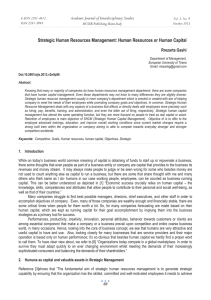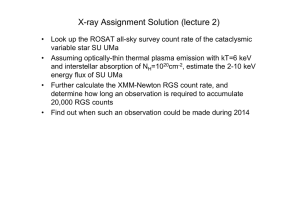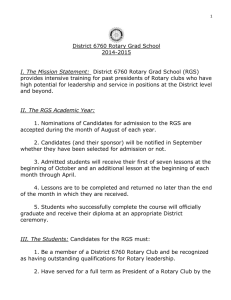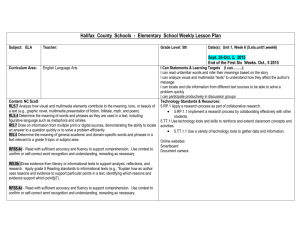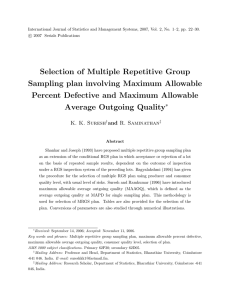STANDARD INTERCONNECTION AGREEMENT
advertisement
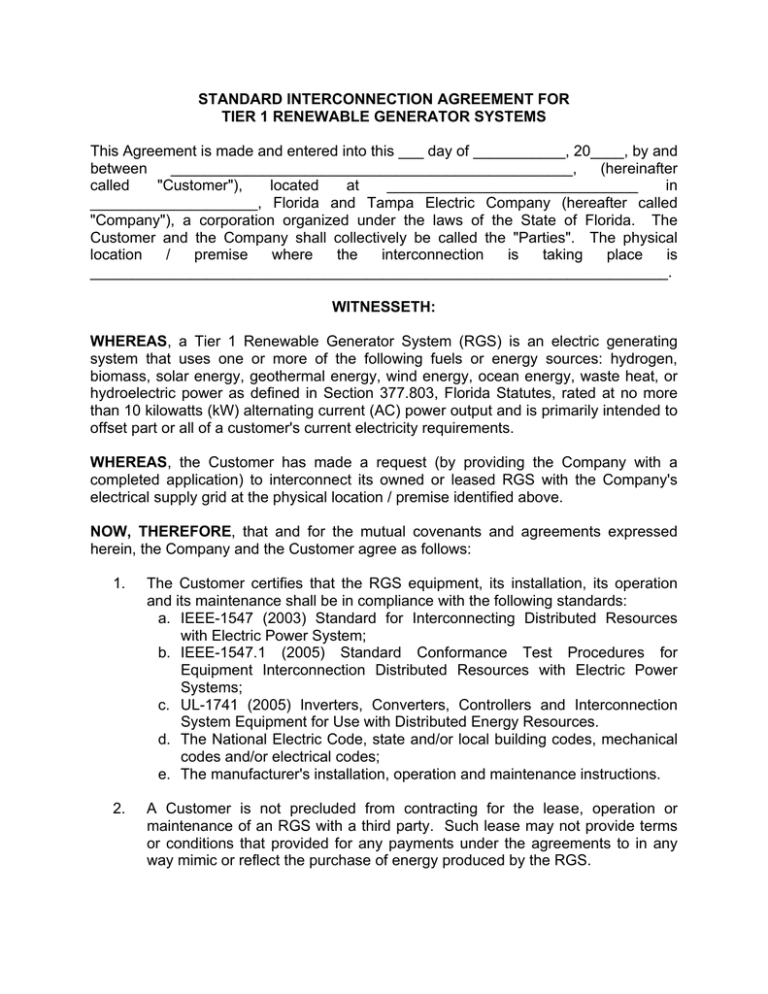
STANDARD INTERCONNECTION AGREEMENT FOR TIER 1 RENEWABLE GENERATOR SYSTEMS This Agreement is made and entered into this ___ day of ___________, 20____, by and between ________________________________________________, (hereinafter called "Customer"), located at ______________________________ in ____________________, Florida and Tampa Electric Company (hereafter called "Company"), a corporation organized under the laws of the State of Florida. The Customer and the Company shall collectively be called the "Parties". The physical location / premise where the interconnection is taking place is _____________________________________________________________________. WITNESSETH: WHEREAS, a Tier 1 Renewable Generator System (RGS) is an electric generating system that uses one or more of the following fuels or energy sources: hydrogen, biomass, solar energy, geothermal energy, wind energy, ocean energy, waste heat, or hydroelectric power as defined in Section 377.803, Florida Statutes, rated at no more than 10 kilowatts (kW) alternating current (AC) power output and is primarily intended to offset part or all of a customer's current electricity requirements. WHEREAS, the Customer has made a request (by providing the Company with a completed application) to interconnect its owned or leased RGS with the Company's electrical supply grid at the physical location / premise identified above. NOW, THEREFORE, that and for the mutual covenants and agreements expressed herein, the Company and the Customer agree as follows: 1. The Customer certifies that the RGS equipment, its installation, its operation and its maintenance shall be in compliance with the following standards: a. IEEE-1547 (2003) Standard for Interconnecting Distributed Resources with Electric Power System; b. IEEE-1547.1 (2005) Standard Conformance Test Procedures for Equipment Interconnection Distributed Resources with Electric Power Systems; c. UL-1741 (2005) Inverters, Converters, Controllers and Interconnection System Equipment for Use with Distributed Energy Resources. d. The National Electric Code, state and/or local building codes, mechanical codes and/or electrical codes; e. The manufacturer's installation, operation and maintenance instructions. 2. A Customer is not precluded from contracting for the lease, operation or maintenance of an RGS with a third party. Such lease may not provide terms or conditions that provided for any payments under the agreements to in any way mimic or reflect the purchase of energy produced by the RGS. 3. The Customer shall provide a copy of the manufacturer’s installation, operation and maintenance instructions to the Company. If the RGS is leased to the Customer by a third party, or if operation or maintenance of the RGS is to be performed by a third party, the lease or performance agreements and any pertinent documents related to those agreements, shall be provided to the Company. 4. The Customer shall have the completed RGS inspected and approved by the appropriate code authorities having jurisdiction. The Customer shall provide proof of this inspection and approval to the Company. 5. The Customer certifies that the RGS equipment includes a utility-interactive inverter or interconnection system equipment that ceases to interconnect with the utility upon a loss of utility power. The inverter shall be considered certified for interconnected operation if it has been submitted by a manufacturer to a nationally recognized testing laboratory (NRTL) to comply with UL 1741. The NRTL shall be approved by the Occupational Safety & Health Administration (OSHA). 6. The Customer’s utility-interactive inverter shall not energize the Company’s system when the Company’s system is de-energized. The Customer’s utility-interactive inverter shall cease to energize the Company’s system during a faulted condition on the Company’s system. The Customer’s utility-interactive inverter shall cease to energize the Company’s system prior to the automatic or non-automatic reclosing of the Company’s protective device(s). There shall be no intentional islanding, as described in IEEE 1547, between the Customer’s and the Company’s systems. 7. “Gross power rating” (GPR) means the total manufacturer’s AC nameplate generating capacity of an on-site customer-owned renewable generation system that will be interconnected to and operate in parallel with the investorowned utility’s distribution facilities. For inverter-based systems, the GPR shall be calculated by multiplying the total installed DC nameplate generating capacity by .85 in order to account for losses during the conversion from DC to AC. It is the Customer’s responsibility to notify the Company of any change to the GPR of the RGS by submitting a new application for interconnection specifying the modifications at least 30 days prior to making the modifications. Increase in GPR above the 10 kW limit would necessitate entering into a new agreement at either Tier 2 or Tier 3 which may impose additional requirements on the Customer. In any case, increases in GPR above 2 megawatts (MW) would necessitate an entirely new interconnection process not covered under the Tier 1, Tier 2 or Tier 3 agreements. 8. The RGS must have a GPR that does not exceed 90% of the Customer’s utility distribution service rating at the Customer’s location. If the GPR does exceed that 90% limit, the Customer shall be responsible to pay the cost of upgrades for that distribution service to accommodate the GPR capacity and ensure the 90% threshold is not breached. 9. Subject to an approved inspection, including installation of acceptable disconnect switch, this Agreement shall be executed by the Company within 30 calendar days of receipt of a completed application. The Company encourages the Customer to maintain general liability insurance for personal injury and property damage in the amount of not less than one hundred thousand dollars ($100,000). 10. The Customer is responsible for the protection of its generation equipment, inverters, protection devices, and other system components from damage from the normal and abnormal operations that occur on the Company's utility system in delivering and restoring system power. The Customer is also responsible for ensuring that the RGS equipment is inspected, maintained, and tested regularly in accordance with the manufacturer's instructions to ensure that it is operating correctly and safely. Such inspection should occur after large storms have traversed the Customer’s location and after connection with the Company’s system has been restored. 11. The Customer shall install, at the Company’s expense and subject to the approval of the cost by the Company, a manual disconnect switch of the visible load break type to provide a separation point between the AC power output of the RGS and any Customer wiring connected to the Company's utility system such that back feed from the RGS to the Company's utility system cannot occur when the switch is in the open position. The manual disconnect switch shall be mounted separate from the meter socket on an exterior surface adjacent to the meter. The switch shall be readily accessible to the Company and capable of being locked in the open position with a Company padlock. When locked and tagged in the open position by the Company, this switch will be under the control of the Company. If the switch installation cost proposed by the Customer or the Customer’s contractor exceeds the Company’s cost to have the switch installed through its own means, the Company shall install the switch, and the Customer shall provide reasonable accommodation to the Company for such installation. See Company website for information regarding Company’s cost for switch installation. 12. The Company may open the switch, isolating the RGS, without prior notice to the Customer. To the extent practical, however, prior notice shall be given. If prior notice is not given, the utility shall at the time of disconnection leave a door hanger notifying the Customer that the RGS has been disconnected, including an explanation of the condition necessitating such action. The switch will be re-closed by the Company as soon as practical once the conditions causing the disconnection cease to exist. Conditions which may require the switch to be opened include: • • • Company utility system emergencies or maintenance requirements. Hazardous conditions existing on the Company's utility system due to the operation of the Customer's RGS generation or protective equipment as determined by the Company. Adverse electrical effects (such as power quality problems) on the electrical equipment of the company's other electric consumers caused by the RGS as determined by the Company. 13. a. The Customer agrees to indemnify and hold harmless the Company, its subsidiaries or affiliates, and their respective employees, officers and directors, against any and all liability, loss, damage, cost, claims or expense, including attorney's fees, which the Company, its subsidiaries, affiliates, and their respective employees, officers and directors may hereafter incur, suffer or be required to pay by reason of negligence on the part of the Customer under the obligation of this Agreement. The Company agrees to indemnify and hold harmless the Customer, its subsidiaries or affiliates, and their respective employees, officers and directors, against any and all liability, loss, damage, cost, claims or expense, including attorney's fees, which the Customer, its subsidiaries or affiliates, and their respective employees, officers and directors may hereafter incur, suffer or be required to pay by reason of negligence on the part of the Company under the obligations of this Agreement. b. With respect to a Customer that is the state, a state agency or subdivision (as those terms are defined in Section 768.28(2), Florida Statutes, or the successor thereto), the obligations of Customer set forth in Paragraph 13.a above shall be subject to Section 768.28 (or the successor thereto), including the limitations contained therein. With respect to a Customer that is the United States of America, or agency or subdivision thereof, the obligations set forth in the first sentence of Paragraph 13.a shall not apply. In either case, the Company reserves its rights under Section 768.28 (or the successor thereto), and the Federal Tort Claims Act (or the successor thereto), as applicable, including, but not limited to, the right to pursue legislative relief. 14. In no event shall any statement, representation, or lack thereof, either express or implied, by the Company, relieve the Customer of exclusive responsibility for the Customer's RGS. Specifically, any Company inspection of the RGS shall not be construed as confirming or endorsing the RGS design or its operating or maintenance procedures nor as a warranty or guarantee as to the safety, reliability, or durability of the RGS equipment. The Company's inspection, acceptance, or its failure to inspect shall not be deemed an endorsement of any RGS equipment or procedure. 15. The Company will furnish, install, own and maintain metering equipment to measure kilowatt-hours (kWh) of energy and, if applicable, the kW of demand and time of use of said energy and demand. The Customer's service associated with the RGS will be metered at a single metering point and the metering equipment will measure energy delivered by the Company to the Customer, and also measure energy delivered by the Customer to the Company. The Customer agrees to provide safe and reasonable access to the premises for installation of this equipment and its future maintenance or removal. 16. The Customer agrees to permit the Company, if it should so choose, to inspect the RGS and its component equipment and the documents necessary to ensure compliance with various sections of this Agreement both before and after the Customer RGS goes into service and to witness the initial testing of the Customer's RGS equipment and protective apparatus. The Company shall provide the Customer with as much notice as reasonably practicable; either in writing, e-mail, facsimile or by phone, as to when the Company may conduct inspection or document review. Upon reasonable notice, Customer shall not unreasonably refuse the Company access to the Customer’s premises for any reasonable purpose in connection with the performance of the obligations imposed by the Agreement or, if necessary, to meet the Company’s legal obligation to provide service to its customers. At any time without notice in the event of an emergency or hazardous condition, the Company shall have access to the Customer’s premises to operate the manual disconnect switch. The Customer shall notify the Company at least 10 days prior to the in-service date of the RGS to provide sufficient notice for the Company to be able to be present, if it so chooses, when the RGS is placed in service. 17. Once the Company has received the Customer's written documentation that the requirements of this Agreement have been met and the correct operation of the manual switch has been demonstrated to a Company representative, the Company will, within 10 business days, send written notice that parallel operation of the RGS may commence. 18. The Customer shall not have the right to assign its benefits or obligations under this Agreement without the Company's prior written consent and such consent shall not be unreasonably withheld. The Company may require the assignee to sign a new copy of this Agreement, agreeing to all its requirements and paying the applicable processing charge. Heirs, assigns, et al would not be required to pay an application fee when signing a new interconnection agreement as long as there is no change to the capacity of the equipment. 19. In executing this Agreement, the Company does not, nor should it be construed to extend its credit or financial support for the benefit or any third parties lending money to or having other transactions with Customer or any assignee of this Agreement. 20. On termination of services pursuant to this Agreement, the Company shall open and padlock the manual disconnect switch and remove any additional metering equipment related to this Agreement. At the Customer’s expense, within 10 working days following the termination, the Customer shall permanently isolate the RGS and any associated equipment from the Company’s electric supply system, notify the Company that the isolation is complete, and coordinate with the Company for return of the Company’s lock. 21. This Agreement supersedes all previous agreements and representations either written or verbal heretofore made between the Company and Customer with respect to matters herein contained. This Agreement, when duly executed, constitutes the only Agreement between parties hereto relative to the matters herein described. 22. This Agreement shall be governed by and construed and enforced in accordance with the laws, rules and regulations of the State of Florida and the Company’s Tariff as it may be modified, changed, or amended from time to time. 23. This Agreement incorporates by reference the terms of the tariff filed with the Florida Public Serviced Commission by Tampa Electric Company, including Rate Schedule NM-1, and associated technical terms and abbreviations, general rules and regulations and standard electric service requirements (as may be applicable) are incorporated by reference, as amended from time to time. To the extent of any conflict between this Agreement and such tariff, the tariff shall control. 24. The Company and Customer recognize that the Florida Public Service Commission Rules, including those Rules directly addressing the subject of this Agreement, may be amended from time to time. In the event that such rules are amended that affect the terms and conditions of this Agreement, the Company and Customer agree to supersede and replace this Agreement with a new Interconnection Agreement which complies with the amended rules. 25. This Agreement shall inure to the benefit of and be binding upon the respective heirs, legal representatives, successors and assigns of the parties hereto. If this Agreement is assigned, the Customer shall notify the Company prior to the effective date of the assignment. 26. The Company or Customer may seek resolution of disputes arising out of the interpretation of this Agreement pursuant to Rule 25-22.032, F.A.C. Customer Complaints, or Rule 25-22.036, F.A.C., Initiation of Formal Proceedings. IN WITNESS WHEREOF, Customer and the Company have executed this Agreement the day and year first above written. CUSTOMER By: _____________________________ Its: _____________________________ COMPANY By: _____________________________ Its: _____________________________

